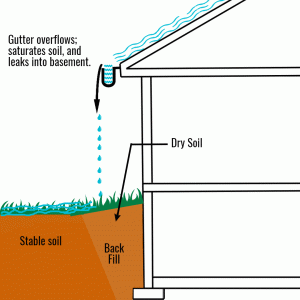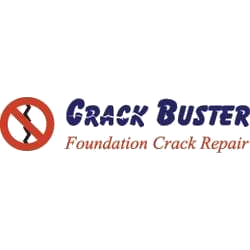SETTLEMENT
There is always a degree of settlement involved in any building project. The thing that a homeowner is interested in is to what degree the foundation will settle. Tiny shifts can be easily dealt with but large scale settlement can be disastrous. There are many sources  of settlement. Some originate from faulty mechanics during the building process (improper mixing of the concrete, curing the concrete too rapidly, premature backfilling against the foundation, etc.). The majority, however, have to do with the soil conditions at the site—especially directly underneath the footings. Any time soil is disturbed as it is in the excavation process there will always be adjustment until the soil comes to a new stable configuration. Anyone who has played in a sandbox knows that it makes a big difference whether or not you pack the sand tightly in the pail before turning it over. In a similar way, soil needs to be compacted at the time the foundation footing is laid. Sometimes, even properly compacted soil can develop voids. If a foundation is laid over soil which contains significant organic material, the organic material can decay, leaving pockets in the soil.
of settlement. Some originate from faulty mechanics during the building process (improper mixing of the concrete, curing the concrete too rapidly, premature backfilling against the foundation, etc.). The majority, however, have to do with the soil conditions at the site—especially directly underneath the footings. Any time soil is disturbed as it is in the excavation process there will always be adjustment until the soil comes to a new stable configuration. Anyone who has played in a sandbox knows that it makes a big difference whether or not you pack the sand tightly in the pail before turning it over. In a similar way, soil needs to be compacted at the time the foundation footing is laid. Sometimes, even properly compacted soil can develop voids. If a foundation is laid over soil which contains significant organic material, the organic material can decay, leaving pockets in the soil.
 Most settlement problems stem from extremes in moisture conditions under the footings. If the movement of water through the soil under the foundation is not uniform, isolated shifts can occur in the soil supporting the footings. Supporting soil can be eroded out from under footings by water movement. Moisture can collect unevenly beneath the footings, and the wet regions could be subject to frost heaves. Because some degree of settlement always occurs, there are always some stresses on the foundation. These stresses due to settlement often cause cracks in the foundation, but not all cracks that develop in the foundation are due to settlement.
Most settlement problems stem from extremes in moisture conditions under the footings. If the movement of water through the soil under the foundation is not uniform, isolated shifts can occur in the soil supporting the footings. Supporting soil can be eroded out from under footings by water movement. Moisture can collect unevenly beneath the footings, and the wet regions could be subject to frost heaves. Because some degree of settlement always occurs, there are always some stresses on the foundation. These stresses due to settlement often cause cracks in the foundation, but not all cracks that develop in the foundation are due to settlement.
Fortunately, cracks that result from foundation settlement are often easily recognized and dealt with. Prior to building, you can minimize settlement by studying the building site, testing the soil, and properly planning excavation for the foundation. But what about after you’ve built? Chances are, you’re not dealing with a “Leaning Tower of Pisa” and there are effective steps you can take to address the results of settlement on your existing foundation.

There are no comments